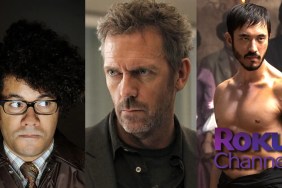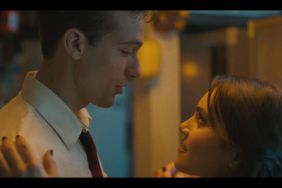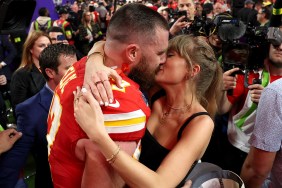Updating the 1941 Universal classic
More coverage: Legacy of the Lycanthrope: A Werewolf Timeline | Rick Baker Interview| Video: Exclusive Cast Interviews

Fifteen minutes isn’t enough time to talk to Joe Johnston. Especially when the topic of discussion is Universal’s remake of The Wolfman, opening on February 12. Nevertheless, when the director sits down one-on-one with Shock Till You Drop the weekend before his film’s release, that’s all the time we’ve got.
If I had my way, I’d want an hour or two to really dig into the man’s cranium and pick his brain about updating screenwriter Curt Siodmak and director George Waggner’s 1941 tale of the cursed Larry Talbot (originally played by Lon Chaney, Jr., now essayed by producer/actor Benicio Del Toro). Because Johnston, as you may have read on this site over the last year, had the unenviable task of picking up the project after original director Mark Romanek (One Hour Photo) parted ways with Universal over creative differences (Johnston already had a previous relationship with the studio after helming October Sky and Jurassic Park III). He only had weeks before cameras began to roll in England, yet he made the conditions work.
This rush into principal photography would contradict The Wolfman‘s sluggish push through post-production which would call for re-shoots, an expansion of the visual FX grocery list and release date delays. One could say Johnston, like Talbot, was cursed in his own way.
So, you see what I mean. Fifteen minutes is an inadequate amount of time to get the full skinny on the creation of the new Wolfman. However, in talking with the director, breaking from his pre-production duties on The First Avenger: Captain America, I got him to open up about the project, some of the decisions that were made in post-production and the battles he faced.
Entering the room, my conversation immediately begins with reminiscing about our favorite Universal monsters (as any chat between two “monster kids” should begin). He tells me he’s a fan of Creature from the Black Lagoon. No, he didn’t try to get the Creature from the Black Lagoon remake job.

Ryan Rotten: When screenwriter Curt Siodmak was brought aboard the original Wolf Man, Universal already had a cast lined up and they gave him a narrow window of time to turn in a script. This is echoed in your case where you only had a small amount of time to prepâ¦
Joe Johnston: It’s impossible to make a film like this with three weeks of prep. Had I started from ground zero, there was no way I could do it. Mark Romanek had, I didn’t know what, but he had done something. I was pleasantly surprised that it wasn’t a sinking ship I had been airlifted onto. He made a lot of good choices. I was able to change a lot more than I expected. I was able to re-cast some parts, some of the supporting actors. While I’m making a completely different film than Mark would have made, he provided some ingredients that fit into the version I wanted to make. The other thing about it is when you get put in a situation like that, you have to say, “Okay, I’ve got three weeks of prep here. We’re going to start shooting March 3, or whatever it is, I don’t have time to sit down an analyze this script and decide what I’d like to do and start intellectualizing about it.” I have to read it and trust my instincts. That was the only way to do it. It was an interesting exercise, while I wouldn’t want to do it again, I have to remember my first instinct is usually right. Because sometimes I would either have self doubt or get talked into considering something else, I usually realize what I came back to is what I wanted in the first place.
Rotten: From what you’re saying, it sound an awful lot like what I hear when I talk to indie film directors and the time constraints they’re put under. Where their creativity is pushed into a fly by the seat of your pants situation.
Johnston: That’s pretty much what it was. I did have great support, but when you have support like that it means that’s something you don’t have to worry about. I didn’t have to worry about the photography, I didn’t have to worry about the visual FX or the production design so I could focus on the interplay amongst these four characters and make it interesting. There’s always a battle with the studio about what the movie is. I think I was fairly successful in convincing the studio that mine was the right version or with, at least, postponing the battles until it was too late. I don’t think it’s the movie they thought they were going to get and they’re pleasantly surprised with what it is and how it turned out. With a movie this size you can’t turn to them and say, “Hey, leave me alone to make a movie and I’ll show you what I have in ten months.” It doesn’t work that way. It takes a lot of energy just to deal with that side of it. You’ve got the guys in the studio and it’s like, “Okay, I’ll listen to your ideas, but you have to listen to mine.” It’s definitely a power struggle.

Rotten: You talked earlier of a 17-minute extended cut that’s coming to DVD. Is there a definitive Joe Johnston cut?
Johnston: Well, I have to say that I always question what a director’s cut is. Because if the release print is not the director’s cut then you rolled over. And what I’m calling the DVD is the extended cut because we’re putting back in, in a perfect world, I would have left in. When audiences say, “Hey, it’s slow for the first 15 minutes,” you have to listen to them. For better or worse, this is a movie business we’re in and we’re in the business of selling tickets. You want the audience to see the movie, be entertained and then go tell their friends to see it. I recognize that. You’re walking a fine line between art and commerce, and I recognize the line is there and I have to walk it like anyone else.
Rotten: This film takes the classic Universal monsters aesthetic and lets scenes breathe. It definitely has a pace, at times, that’s the antithesis of what we see in contemporary horror films.
Johnston: Visually I wanted the film to look like it belonged in 1890. That’s important, I didn’t want it to look like a film that was shot in 1890, but when you watch the film, you recognize youâre in a different place. And you reset the constructs in your mind. You’re not expecting Saw VI, or something. This is different. Something like that is tough for a studio to recognize. I understand why. Selfishly, it’s not my money and I want to put my version of the movie on the screen. I have to say, The Wolfman, my version, is closer to me than anyone else’s. As hard as it is to fight those battles.

We didn’t because the pentagram was the thing that became supernatural element. A paranormal thing – the ability to see it appear on the victim’s hand. Suddenly it’s no longer about being bitten and a virus running through your body and curse. It’s something supernatural and we wanted to avoidâ¦not that being bitten and turning into a wolfman isn’t supernatural, it was of another realm.
Rotten: I also noticed the absence of a scene that was used in early trailers which found the Wolfman in a ballroom attacking someone. Why did you decide to cut it out? I presume this scene had taken place during the London chase sequence.
Johnston: It was at the end of the London chase. What happened – and this has happened to me many times before – in pre-production you try to make the film affordable. There’s a certain amount of money you can spend and there was a sequence in the original script where he rampages through London, very similar to what we ended up with, and it ended at this conservatory. We couldn’t afford a London chase, but we afford the conservatory part. So we shot that. After we cut the film, we recognized – everyone recognized – that, “Gee, we want this action sequence of him rampaging through London.” We went back to shoot it, along with another sequence. We added about 200 more visual FX shots, which meant not only did we have to push the release date, we had to come up with more FX money. Also, once we cut it together, the conservatory scene played at a different pace. It didn’t fit anymore. You didn’t want to see the Wolfman stop at this conservatory where a ball is happening and everyone thinks he’s in a costume – which is what the gag was. So, it’s in the deleted scenes. [laughs] If you really want to see it, there it is.

It does. Danny had to score a film that was half an hour longer [than what the film is now]. And he had to score it very early. It was last summer, I think. He said, “This has happened to me before, and I know it’s going to happen now. You’re going to re-cut the film and my score isn’t going to work.” We re-cut the film, we put his score in. And what happened is he had themes he had spaced out and it worked great in his cut. When we took out that half hour, his themes were closer together. So things get familiar and you go, “Wait, I just heard that.” We previewed the film, we all recognized it didn’t work. But there was a reaction from someone high up at NBC/Universal, because a new trailer had been cut with the electronic score, someone said, “Hey, let’s do the whole film that way!” It was something I reacted to pretty violently. That’s the wrong idea, guys. They said they were going to try it. I had been so worn down, I said, “Okay, let’s try it.” They hired a guy who is a talented composer in his own right. They assigned him something that was almost impossible to do. When we put his music to the picture, even though the music was working, it was so out of context with what you were seeing. You can do anything in a trailer, put any music in and the audience doesn’t see that trailer and go to the movie expecting that music. So the studio, to their credit, after they heard the new score, recognized Danny had a better score that matched the film. We then went back in to record about 15 minutes of new material.
The Wolfman stars Benicio Del Toro, Anthony Hopkins, Emily Blunt and Hugo Weaving. For clips, trailers and photos from the film, simply click on the title link.
More coverage to come!





Source: Ryan Rotten, Managing Editor









